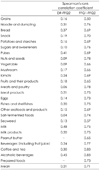Abstract
Assessing human exposure to food-borne hazards requires standardized assessment tools. The objective of this study was to validate a newly developed dietary assessment questionnaire to assess human exposure to food-borne hazards, which include dietary behavior and food consumption patterns such as eating frequency, types of food containers and cooking methods. A total of 216 adults were recruited for two questionnaire surveys (questionnaire 1 and 2) about 1 week apart with a 3 day diet record. Reproducibility was evaluated by comparing responses from questionnaires 1 and 2, and validity was checked by comparing responses from questionnaire 2 and the 3 day diet record. Comparisons were based on the percent agreement and Spearman's rank correlation coefficient. The mean exact agreement of food containers at purchase between questionnaires 1 and 2 was 73.5%, for storing containers it was 71.9%, and for cooking methods it was 83.0%. The mean correlation coefficient for food intake frequency between questionnaires 1 and 2 was 0.71 (range, 0.50?0.83). The mean correlation coefficient of the food intake frequency between questionnaire 2 and the 3 day diet record was 0.21 (range, 0.04-0.48). The exact and adjacent agreement of food intake frequency quartile assessed by questionnaire 2 and the 3 day diet record was 65.4% (range, 51.0-82.1%). Although the correlation coefficient for food intake frequency between questionnaire 2 and the 3 day diet record was low, the exact and adjacent food intake frequency agreement was higher than 50% and reproducibility of the dietary behaviors exceeded 70%. Therefore, the questionnaire developed in this study could be applied to assess diets for the human exposure to food-borne hazards as a qualitative assessment in a large population.
Figures and Tables
References
1. World Health Organization. Food safety risk analysis: A guide for national food safety authorities. 2006.
2. Joung H. Developing a questionnaire for exposure assessment of food-borne hazards. Research Report of Korea Food & Drug Administration (KFDA). 2010. 5–6.
3. Cho YH. Dietary intake and risk assessment of contaminants in Korean foods. Research report of Korea Food & Drug Administration (KFDA). 2005. 24–25.
4. Choi DW. Dietary intake and risk assessment of contaminants in Korean foods. Research report of Korea Food & Drug Administration (KFDA). 2007. 37–39.
5. Choi DW. Dietary intake and risk assessment of contaminants in Korean foods. Research report of Korea Food & Drug Administration (KFDA). 2008. 40–42.
6. Choi DW. Dietary intake and risk assessment of contaminants in Korean foods. Research report of Korea Food & Drug Administration (KFDA). 2009. 44–46.
7. Lee HS. Dietary intake and risk assessment of contaminants in Korean foods. Research report of Korea Food & Drug Administration (KFDA). 2004. 51–54.
8. Moon JS. Dietary intake and risk assessment of contaminants in Korean foods. Research report of Korea Food & Drug Administration (KFDA). 2002. 23–27.
9. Moon JS. Dietary intake and risk assessment of contaminants in Korean foods. Research report of Korea Food & Drug Administration (KFDA). 2003. 65–68.
10. Park SO. Dietary intake and risk assessment of contaminants in Korean foods. Research report of Korea Food & Drug Administration (KFDA). 2006. 21–46.
11. Park SY, Kim S, Kim C, Lee S, Yoo KY, Yang M. Biological monitoring in a Korean population. Research report of Korea Food & Drug Administration (KFDA). 2002. 23–39.
12. Roh JH. Biological monitoring exposure to lead and lifestyle factors as determinants of blood lead level. Research report of Korea Food & Drug Administration (KFDA). 2005. 11–18.
13. Park JD. Assessment of exposure to arsenic in Korean. Research Report of Korea Food & Drug Administration (KFDA). 2004. 14–19.
14. Choi KH. Human exposure assessment for antibiotics in the water environment. Research report of Korea Food & Drug Administration (KFDA). 2007. 20–22.
15. Willet WC. Nutritional epidemiology. 1998. 2 ed. New York: Oxford University Press.
16. Ambrosini GL, Klerk NH, O'Sullivan TA, Beilin LJ, Oddy WH. The reliabiliity of a food frequency questionnaire for use among adolescents. Eur J Clin Nutr. 2009. 63:1251–1259.

17. Huybrechts I, De Backer G, De Bacquer D, Maes L, De Henauw S. Relative validity and reproducibility of a food-frequency questionnaire for estimating food intakes among Flemish preschoolers. Int J Environ Res Public Health. 2009. 6:382–399.

18. Zhang B, Wang P, Chen CG, He QQ, Zhuo SY, Chen YM, Su YX. Validation of an FFQ to estimate the intake of fatty acids using erythrocyte membrane fatty acids and multiple 3d dietary records. Public Health Nutr. 2009. 13(10):1546–1552.

19. Hong SB, Choi YJ, Lee HJ, Kim SH, Oe YJ, Lee SY, Nam MS, Kim YS. Development and validation of a semi-quantitative food frequency questionnaire to assess diets of korean type 2 diabetic patients. Korean Diabetes J. 2010. 34:32–39.

20. Ji SK, Kim HS, Choi HM. Study on development and validation of food frequency questionnaire for estimating energy intake of women in child-bearing age. Korean J Community Nutr. 2008. 13(1):111–124.
21. Ahn Y, Kwon E, Shim JE, Park MK, Joo Y, Kimm K, Park C, Kim DH. Validation and reproducibility of food frequency questionnaire for Korean genome epidemiologic study. Eur J Clin Nutr. 2007. 61(12):1435–1441.

22. Won HS, Kim WY. Development and validation of a semi-quantitative food frequency questionnaire to evaluate nutritional status of Korean elderly. Korean J Nutr. 2000. 33(3):314–323.
23. Nomura A, Hankin JH, Rhoads GG. The reproducibility of dietary intake data in a prospective study of gastrointestinal cancer. Am J Clin Nutr. 1976. 29(12):1432–1436.

24. Jacobsen BK, Bonaa KH. The reproducibility of dietary data from a self-administered questionnaire. The Tromso Study. Int J Epidemiol. 1990. 19(2):349–353.

25. Van Liere MJ, Lucas F, Clavel F, Slimani N, Villeminot S. Relative validity and reproducibility of a French dietary history questionnaire. Int J Epidemiol. 1997. 26:Suppl 1. S128–S136.





 PDF
PDF ePub
ePub Citation
Citation Print
Print








 XML Download
XML Download